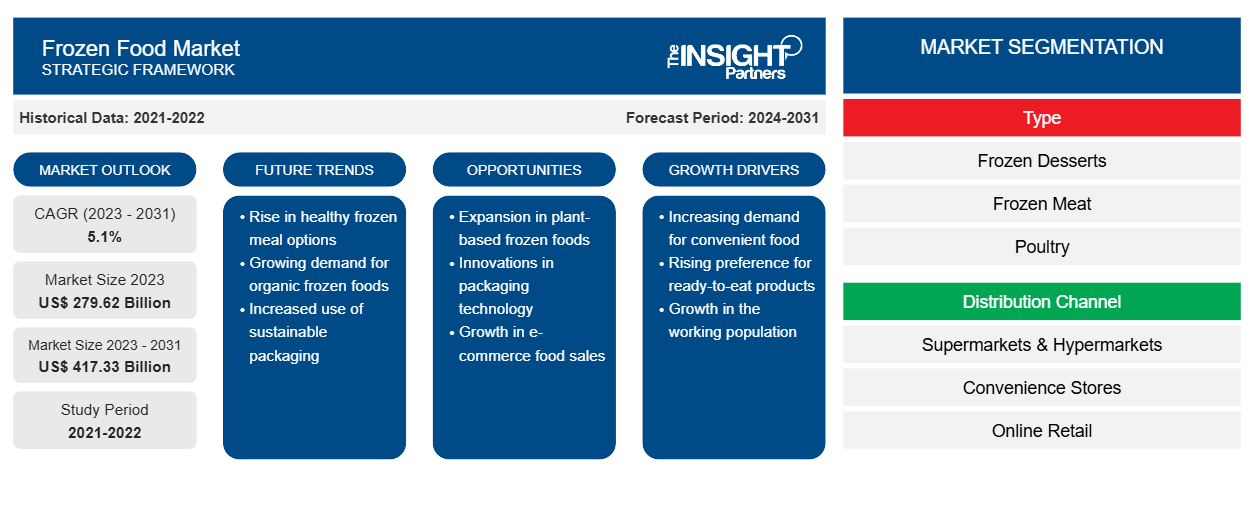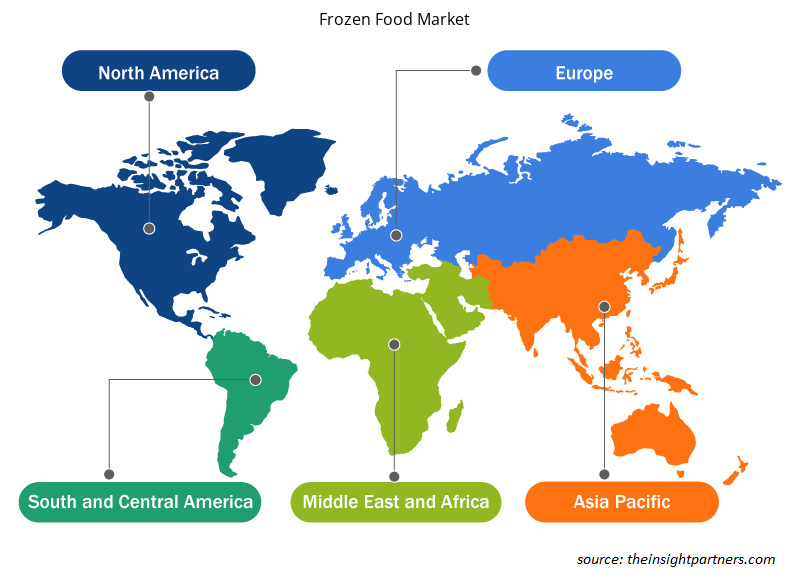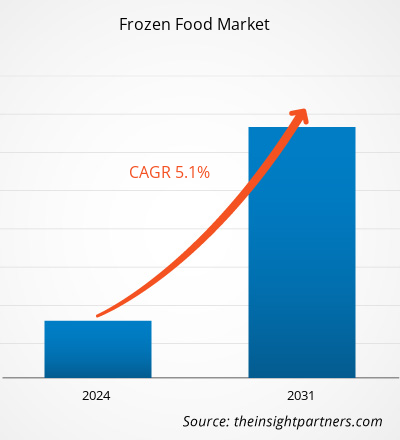冷冻食品市场规模预计将从2024年的2.9539亿美元增至2031年的4.4422亿美元;预测期内,复合年增长率有望达到6.0%。近年来,纯素食主义发展势头强劲。消费者普遍倾向于植物性产品,因为他们认为植物性产品比传统产品更健康。此外,动物保护和环境可持续性意识的增强也推动了这些食品的普及。全球纯素食主义浪潮的兴起,对冷冻食品市场的创新产生了深远的影响。
冷冻食品市场分析
过去几年,世界各地人们的生活方式发生了翻天覆地的变化。由于繁忙的工作日程,人们对省时省力产品的依赖日益增加。高品质方便食品消费的激增是食品行业最大的趋势之一。方便食品,例如冷冻零食、冷冻食品、冷盘和即食产品,可以让消费者节省采购食材、准备和烹饪食物、食用以及餐后活动的时间和精力。这些食品的发展和流行归因于许多社会变化;其中最显著的是全球小家庭数量的增加和千禧一代人口的增加。由于繁忙的工作日程,千禧一代更倾向于高效利用时间,而不是将时间浪费在繁琐的任务上。因此,他们更有可能将钱花在方便食品上。这些因素显著刺激了消费者对方便食品的需求,最终推动了冷冻食品市场的增长。
冷冻食品市场概况
冷冻食品包括冰淇淋、冷冻酸奶、冷冻肉类、冷冻海鲜、冷冻即食食品、小吃、开胃菜、汤品、水果和蔬菜。这些产品在零下25摄氏度左右冷冻保存。冷冻食品不含人工防腐剂,比其他加工食品更健康。此外,它们可以轻松储存在零下25摄氏度的家用冰箱中。人们忙碌的生活方式导致对方便食品的需求不断增长,这推动了冷冻食品市场的增长。此外,快速的城市化、人均收入的提高以及零售业格局的变化也是推动冷冻食品市场增长的一些关键因素。
定制此报告以满足您的要求
您可以免费定制任何报告,包括本报告的部分内容、国家级分析、Excel 数据包,以及为初创企业和大学提供优惠和折扣
冷冻食品市场:战略洞察

-
获取此报告的顶级关键市场趋势。此免费样品将包括数据分析,从市场趋势到估计和预测。
冷冻食品市场的驱动因素和机遇
电子商务蓬勃发展利好市场
人们越来越倾向于通过线上零售平台购买冷冻食品。根据美国冷冻食品协会的数据,2020年冷冻食品的线上销售额增长了75%。疫情期间,由于实体店关闭以及政府实施的社交限制措施,食品和饮料的线上销售额大幅增长。由于封锁措施限制了人们的出行,迫使人们居家办公,人们大量转向线上购物。此外,大幅折扣、一站式提供各种品牌商品以及送货上门等其他显著因素也促使消费者转向线上购物。随着电商在不同地区的渗透率不断提高,家乐氏公司、康尼格拉等冷冻食品制造商也纷纷通过亚马逊、利德尔和沃尔玛等知名电商平台销售产品,扩大线上业务。这一因素有助于消除消费者对线下零售店的依赖,从而促进冷冻食品市场的增长。
制造商的战略发展举措——机遇
冷冻食品制造商正在大力投资产品创新,以扩大客户群并满足新兴消费趋势。他们正在推出无麸质、植物基、无糖、有机和清洁标签产品,以及适合生酮饮食的产品,以满足消费者的不同需求。例如,2021 年 8 月,冷冻食品行业的知名品牌 Real Good Foods Company 宣布在全美 1500 家 Kroger 门店推出 7 种新的富含蛋白质、低碳水化合物、无谷物和无麸质的冷冻产品类别。同样,在 2022 年,提供冷冻食品的印度领先品牌 Prasuma 在其冷冻食品产品组合中推出了冷冻零食产品。新推出的产品包括冷冻蔬菜鸡肉春卷、冷冻鸡块、鸡肉蔬菜迷你萨莫萨三角饺、鸡肉羊肉沙米烤肉串和烤肉串,以及培根,丰富了其冷冻零食产品组合。在全球危机期间,健康成为全球消费者的首要任务,而这些产品的推出旨在帮助消费者在享受美食的同时,继续保持健康目标。由于人们开始注重方便食品,同时又注重饮食营养均衡,制造商们纷纷推出营养丰富的冷冻食品。此类产品创新有助于他们扩大影响力,并在国际市场上获得竞争优势。
冷冻食品市场报告细分分析
有助于得出冷冻食品市场分析的关键部分是类型和分销渠道。
- 根据类型,冷冻食品市场分为冷冻甜点;冷冻肉类、家禽和海鲜;冷冻烘焙食品;冷冻小吃和开胃菜;冷冻餐食;以及其他。
- 从分销渠道来看,市场分为超市和大卖场、便利店、网上零售和其他。
冷冻食品市场份额按地区分析
冷冻食品市场报告的地理范围主要分为五个地区:北美、亚太、欧洲、中东和非洲、南美/南美和中美。
欧洲一直主导着冷冻食品市场。欧洲冷冻食品市场分为德国、法国、意大利、英国、俄罗斯和欧洲其他地区。市场增长主要归因于对方便食品的需求不断增长、零售基础设施日益完善以及不同分销渠道提供的各种品牌产品。此外,高人均收入消费者的存在也推动了对冷冻食品(如冷冻餐和零食)的需求。消费者希望从所消费的产品中获得营养。因此,对清洁、有机、无麸质和低加工冷冻食品的需求显著增加,这推动了该地区的市场增长。
冷冻食品市场区域洞察
Insight Partners 的分析师已详尽阐述了预测期内影响冷冻食品市场的区域趋势和因素。本节还讨论了北美、欧洲、亚太地区、中东和非洲以及南美和中美洲的冷冻食品市场细分和地理位置。

- 获取冷冻食品市场的区域具体数据
冷冻食品市场报告范围
| 报告属性 | 细节 |
|---|---|
| 2024年的市场规模 | 2.9539亿美元 |
| 2031年的市场规模 | 4.4422亿美元 |
| 全球复合年增长率(2025-2031) | 6.0% |
| 史料 | 2021-2023 |
| 预测期 | 2025-2031 |
| 涵盖的领域 |
按类型
|
| 覆盖地区和国家 |
北美
|
| 市场领导者和主要公司简介 |
|
冷冻食品市场参与者密度:了解其对商业动态的影响
冷冻食品市场正在快速增长,这得益于终端用户需求的不断增长,而这些需求又源于消费者偏好的不断变化、技术进步以及对产品优势的认知度不断提升等因素。随着需求的增长,企业不断扩展产品线,不断创新以满足消费者需求,并抓住新兴趋势,从而进一步推动市场增长。
市场参与者密度是指特定市场或行业内企业或公司的分布情况。它表明特定市场空间内竞争对手(市场参与者)的数量相对于其规模或总市值而言。
在冷冻食品市场运营的主要公司有:
- 康尼格拉品牌
- 通用磨坊
- Pepperidge农场公司
- 邦杜尔集团
- 麦凯恩食品有限公司
- 贝利西奥食品公司
免责声明:以上列出的公司没有按照任何特定顺序排列。

- 获取冷冻食品市场顶级关键参与者概述
冷冻食品市场新闻及最新发展
冷冻食品市场的评估是通过收集一手资料和二手资料后进行的定性和定量数据进行的,这些数据包括重要的企业出版物、协会数据和数据库。以下列出了言语和语言障碍市场的发展情况及应对策略:
- 2022 年,White Castle 将与 Bellisio Foods 合作,扩大零售食品供应,向全国零售商推出标志性的鸡肉圈(Whistle Castle/公司网站)
冷冻食品市场报告覆盖范围和交付成果
《冷冻食品市场规模和预测(2021-2031)》报告对以下领域进行了详细的市场分析:
- 涵盖范围内所有主要细分市场的全球、区域和国家层面的市场规模和预测
- 市场动态,例如驱动因素、限制因素和关键机遇
- 未来主要趋势
- 详细的 PEST/波特五力分析和 SWOT 分析
- 全球和区域市场分析涵盖关键市场趋势、主要参与者、法规和最新市场发展
- 行业格局和竞争分析,包括市场集中度、热图分析、知名参与者和最新发展
- 详细的公司简介
- 历史分析(2 年)、基准年、预测(7 年)及复合年增长率
- PEST和SWOT分析
- 市场规模、价值/数量 - 全球、区域、国家
- 行业和竞争格局
- Excel 数据集
近期报告
相关报告
客户评价
购买理由
- 明智的决策
- 了解市场动态
- 竞争分析
- 客户洞察
- 市场预测
- 风险规避
- 战略规划
- 投资论证
- 识别新兴市场
- 优化营销策略
- 提升运营效率
- 顺应监管趋势






















 获取免费样品 - 冷冻食品市场
获取免费样品 - 冷冻食品市场